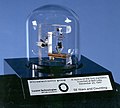Transistor

Atransistoris anelectronic componentthat can be used as part of anamplifier,or as aswitch.[1]It is made of asemiconductormaterial. Transistors are found in mostelectronic devices.The transistor was a major advancement after thetriodetube, with using much less electricity, and lasting many years longer, to switch or amplify another electronic current.
The transistor can be used for a variety of different things including amplifiers and digital switches for computermicroprocessors.Digital work mostly usesMOSFETs.Some transistors are individually packaged, mainly in order to handle high power. Most transistors are insideintegrated circuits.
How they work
[change|change source]
Transistors have three terminals: the gate, the drain, and the source[2](on a bipolar transistor, the wires can be called the emitter, the collector, and the base). When the source (or emitter) is connected to the negative terminal of the battery, and the drain (or collector) to the positive terminal, no electricity will flow in the circuit (if you have only a lamp inserieswith the transistor). But when power flows through the gate (or base), the transistor will allow electricity through. This is because when the gate is positively charged, the positive electrons will push other positive electrons in the transistor letting thenegativeelectrons flow through. The transistor can also work when the gate is just positively charged, so it doesn't need to be touching the drain.
Visualization
[change|change source]An easy way to think of how a transistor works is as a hose with a sharp bend that stops the water from going through. The water is the electrons, and when you positively charge the gate, it unbends the hose, letting water flow.

The basicDarlington transistorcircuit is formed from two bipolar transistors wired emitter to base so they act as one transistor. One of the transistors is connected so that it controls the current to the base of the other transistor. This means that you can control the same amount of current with a very small amount of current going into the base.
Uses
[change|change source]When the gate of a P-channelMOSFETis positively charged, electricity will flow through, this is useful for electronics that require a switch to be turned on, making it an electronic switch. This rivals the mechanical switch, which requires a constant force pressing on it.[3]
In aMOSFETused as an amplifier, transistors take the flow of the drain and source, and since the source current is so much larger than the drain's current, it is common for the drain's current to rise to the value of the sources, amplifying it.[3]
Materials
[change|change source]Transistors are made ofsemiconductorchemical elements, usuallysilicon,which belongs to the modern Group 14 (formerly Group IV) in theperiodic table[4]of elements.Germanium,another group-14 element, is used together with silicon in specialized transistors. Researchers are also studying transistors made from special forms ofcarbon.[5]Transistors can be also made from compounds likegallium arsenide.
History
[change|change source]The transistor was not the first three terminal device. Thetriodeserved the same purpose of the transistor 50 years earlier.Vacuum tubeswere important in household technology before transistors. Unfortunately, tubes were big and fragile, used a lot of power, and didn't last very long. The transistor solved these problems.[6]
Three physicists were credited with the invention of the transistor in 1947:Walter H. Brattain,John Bardeen,andWilliam Shockleywho contributed the most.[7]
Importance
[change|change source]The transistor is a very important component today.[8]If not for the transistor, devices such ascell phonesandcomputerswould be very different, or they might have not been invented at all. Transistors have been made very small (dozens of atoms wide) so that billions of them can be put into a small computer chip.
Gallery
[change|change source]-
Periodic Table of Elements
-
A replica of the first transistor
-
The inventors of the transistor
References
[change|change source]- ↑"The Junction Transistor".1999.Retrieved2012-05-07.
- ↑Calavert, J.B. (4 May 2002)."transisting".Retrieved7 May2012.
- ↑3.03.1"Bipolar Transistors".23 October 2010. Archived fromthe originalon 21 May 2012.Retrieved8 May2012.
- ↑"What are transistors made of?".1998-12-14. Archived fromthe originalon 2012-05-02.Retrieved2012-06-04.
- ↑Nezich, Daniel Andrew (2010).Fabrication and electrical characterization of transistors made from carbon nanotubes and graphene(Thesis). Massachusetts Institute of Technology.hdl:1721.1/62651.Retrieved20 May2012.
- ↑Proffessor David B. Haviland (19 December 2002)."The Transistor-History".Retrieved2012-07-05.
- ↑"History of the Transistor".Archived fromthe originalon 2012-08-18.Retrieved2012-08-05.
- ↑Bestavros, Azer (1995)."From transistor to gates!".Retrieved8 May2012.
Other websites
[change|change source]- AudioUK's MilestonesArchived2007-01-07 at theWayback Machine.Photograph of first working transistor
- 50 Years of the TransistorArchived2007-07-14 at theWayback Machine.FromScience Friday,December 12, 1997
- Bob's Virtual Transistor Museum & HistoryArchived2008-01-21 at theWayback Machine.Treasure trove of transistor history
- How transistors work
- Transistor-Citizendium



